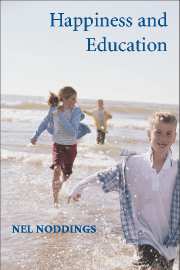12 - Happiness in Schools and Classrooms
Published online by Cambridge University Press: 30 June 2009
Summary
In the previous chapters, we've discussed various views of happiness and a wide range of related topics that might be discussed in schools. We have addressed the broad issue of how best to prepare young people for happy lives. But happiness is not best construed as a state earned or promised for future life. Happiness in the present is not incompatible with future happiness, and it may even be instrumental for future happiness. Educators should therefore give attention to the quality of students’ present experience.
In this chapter, I will use what we've learned about happiness to make some recommendations for life in classrooms. Then, as suggested earlier, I'll show how we might analyze and evaluate our work using the aim of happiness to guide us.
Happy Classrooms
The satisfaction of needs is a major factor in happiness. But needs may be either expressed or inferred, and individuals do not always know what they need. To complicate matters further, it is not easy to separate needs from mere wants, and the satisfaction of wants also contributes to happiness in the form of pleasure. We could probably discuss most of the forms of happiness within the broad general category of satisfaction of needs, but some are so important in themselves that we should return to them now to see how they are involved in the routines of classroom life.
Schools today pay some attention to the satisfaction of physical needs. Hungry children often get free or reduced-price breakfast and lunch.
- Type
- Chapter
- Information
- Happiness and Education , pp. 240 - 262Publisher: Cambridge University PressPrint publication year: 2003



